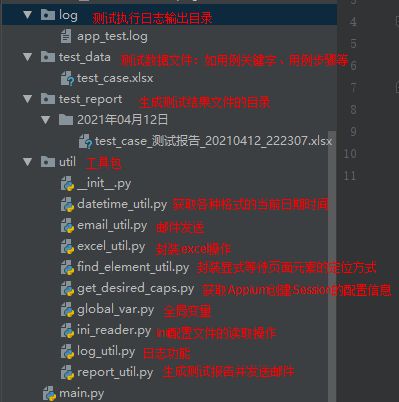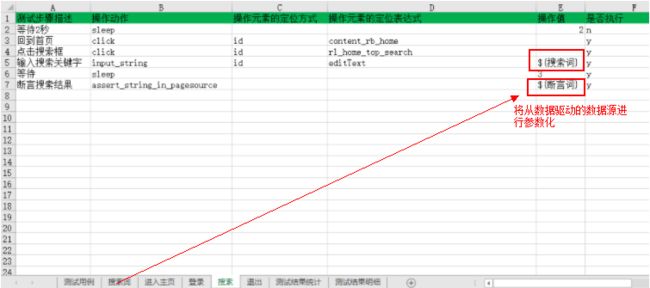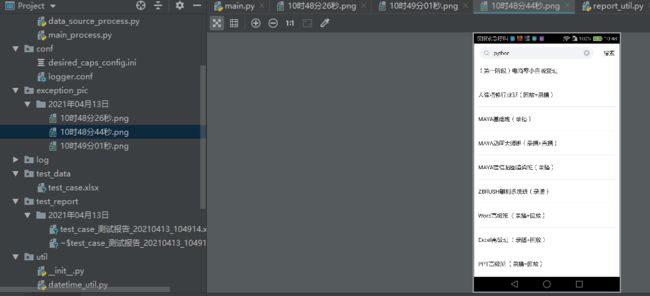Appium自动化测试框架:关键字驱动+数据驱动
1. 关键字驱动框架简介
原理及特点
- 关键字驱动测试是数据驱动测试的一种改进类型,它也被称为表格驱动测试或者基于动作字的测试。
- 主要关键字包括三类:被操作对象(Item)、操作行为(Operation)和操作值(Value),用面向对象形式可将其表现为 Item.Operation(Value)。
- 将测试逻辑按照这些关键字进行分解,形成数据文件。
- 用关键字的形式将测试逻辑封装在数据文件中,测试工具只要能够解释这些关键字即可对其应用自动化。
优势
- 执行人员可以不需要太多的技术:一旦框架建立,手工测试人员和非技术人员都可以很容易的编写自动化测试脚本。
- 简单易懂:它存在 Excel 表格中,没有编码,测试脚本容易阅读和理解。关键字和操作行为这样的手工测试用例,使它变得更容易编写和维护。
- 早期介入:可以在应用未提交测试之前,就可以建立关键字驱动测试用例对象库,从而减少后期工作。使用需求和其它相关文档进行收集信息,关键字数据表可以建立手工测试程序。
- 代码的重用性:用关键字的形式将测试用例及数据进行组装并解释执行,提高代码的可重用性。
2. 框架结构说明
框架结构
整个测试框架分为四层,通过分层的方式,测试代码更容易理解,维护起来较为方便。
第一层是“测试工具层”:
- util 包:用于实现测试过程中调用的工具类方法,例如读取配置文件、页面元素的操作方法、操作 Excel 文件、生成测试报告、发送邮件等。
- conf 包:配置文件及全局变量。
- log 目录:日志输出文件。
- exception_pic 目录:失败用例的截图保存目录。
第二层是“服务层”:相当于对测试对象的一个业务封装。对于接口测试,是对远程方法的一个实现;对于 UI 测试,是对页面元素或操作的一个封装。
- action 包:封装具体的页面动作,如点击、输入文本等。
第三层是“测试用例逻辑层”:该层主要是将服务层封装好的各个业务对象,组织成测试逻辑,进行校验。
- bussiness_process 包:基于关键字的形式,实现单条、多条用例的测试脚本逻辑。
- test_data 目录:Excel 数据文件,包含用例步骤、被操作对象、操作动作、操作值、测试结果等。
第四层是“测试场景层”:将测试用例组织成测试场景,实现各种级别 cases 的管理,如冒烟,回归等测试场景。
- main.py:本框架工程的运行主入口。
框架特点
- 基于关键字测试框架,即使不懂开发技术的测试人员也可以实施自动化测试,便于在整个测试团队中推广和使用自动化测试技术,降低自动化测试实施的技术门槛。
- 使用外部测试数据文件,使用Excel管理测试用例的集合和每个测试用例的所有执行步骤,实现在一个文件中完成测试用例的维护工作。
- 通过定义关键字、操作元素的定位方式和定位表达式和操作值,就可以实现每个测试步骤的执行,可以更加灵活地实现自动化测试的需求。
- 基于关键字的方式,可以进行任意关键字的扩展,以满足更加复杂的自动化测试需求。
- 实现定位表达式和测试代码的分离,实现定位表达式直接在数据文件中进行维护。
- 框架提供日志功能,方便调试和监控自动化测试程序的执行。
3. 框架代码实现
action 包
action 包为框架第二层“服务层”,相当于对测试对象的一个业务封装。对于接口测试,是对远程方法的一个实现;对于 UI 测试,是对页面元素或操作的一个封装。
page_action.py
本模块基于关键字格式,封装了页面操作的常用函数,如打开 APP、点击、输入文本等。
1 import traceback
2 import os
3 import time
4 from appium import webdriver
5 from util.get_desired_caps import get_desired_caps
6 from util.datetime_util import *
7 from util.find_element_util import *
8 from util.global_var import *
9 from util.log_util import *
10
11
12 DRIVER = ""
13
14
15 # 打开APP,获取webdriver对象
16 def open_app():
17 global DRIVER
18 desired_caps = get_desired_caps()
19 DRIVER = webdriver.Remote(APPIUM_SERVER, desired_caps)
20
21
22 # 设定开始活动页
23 def open_start_activity(app_name, start_activity_name):
24 global DRIVER
25 DRIVER.start_activity(app_name, start_activity_name)
26
27
28 # 退出APP
29 def quit_app():
30 global DRIVER
31 DRIVER.quit()
32
33
34 # 在页面输入框中输入数据
35 def input_string(location_type, locator_expression, input_content):
36 global DRIVER
37 find_element(DRIVER, location_type, locator_expression).send_keys(input_content)
38
39
40 # 清除输入框默认内容
41 def clear(location_type, locator_expression):
42 global DRIVER
43 find_element(DRIVER, location_type, locator_expression).clear()
44
45
46 # 点击页面元素
47 def click(location_type, locator_expression):
48 global DRIVER
49 find_element(DRIVER, location_type, locator_expression).click()
50
51
52 # 断言界面源码是否存在某关键字或关键字符串
53 def assert_string_in_pagesource(assert_string):
54 global DRIVER
55 try:
56 assert assert_string in DRIVER.page_source, "%s not found in page source!" % assert_string
57 info("断言成功【关键字:{}】".format(assert_string))
58 except:
59 error("断言失败【关键字:{}】".format(assert_string))
60 raise
61
62
63 # 强制等待
64 def sleep(sleep_seconds):
65 time.sleep(int(sleep_seconds))
66
67
68 # 批量断言
69 def assert_app_list(location_type, locator_expression, assert_string):
70 global DRIVER
71 assert_string_list = assert_string.split(",")
72 elements = find_element(DRIVER, location_type, locator_expression)
73 for element in elements[:3]:
74 assert element.text in assert_string_list
75
76
77 # 截图函数
78 def take_screenshot():
79 global DRIVER
80 # 创建当前日期目录
81 dir = os.path.join(EXCEPION_PIC_PATH, get_chinese_date())
82 if not os.path.exists(dir):
83 os.makedirs(dir)
84 # 以当前时间为文件名
85 file_name = get_chinese_time()
86 file_path = os.path.join(dir, file_name+".png")
87 try:
88 DRIVER.get_screenshot_as_file(file_path)
89 # 返回截图文件的绝对路径
90 return file_path
91 except:
92 print("截图发生异常【{}】".format(file_path))
93 traceback.print_exc()
94 return file_path
business_process 包
business_process 包是框架第三层“测试用例逻辑层”,该层主要是将服务层封装好的各个业务对象,组织成测试逻辑,进行校验。
case_process.py
- 测试用例文件的一行数据,拼接其中的操作动作、操作对象、操作值等关键字,形成与 page_action.py 中的函数相对应的字符串,并通过 eval() 转成表达式以执行用例。
- 记录该用例的测试结果,如测试执行结果、测试执行时间等。
- 如需数据驱动的用例集,则获取数据驱动的数据源集合,循环将每组数据传递给用例步骤。
- 如果遇到需要参数化的值 ${变量名},则根据数据驱动的数据源,根据变量名进行参数化。
data_source_process.py
本模块实现了获取数据驱动所需的数据源集合。
- 根据数据源 sheet 名,获取该 sheet 所有行数据,每行数据作为一组测试数据。
- 每行数据作为一个字典,存储在一个列表中。如 [{"登录用户名": "xxx", "登录密码": "xxx", ...}, {...}, ...]
1 from util.excel_util import Excel
2 from util.global_var import *
3 from util.log_util import *
4
5
6 # 数据驱动
7 # 每行数据作为一个字典,存储在一个列表中。如[{"登录用户名": "xxx", "登录密码": "xxx", ...}, {...}, ...]
8 def get_test_data(excel_file_path, sheet_name):
9 # excel对象初始化
10 if isinstance(excel_file_path, Excel):
11 excel = excel_file_path
12 else:
13 excel = Excel(excel_file_path)
14 # 校验sheet名
15 if not excel.get_sheet(sheet_name):
16 error("sheet【】不存在,停止执行!" % sheet_name)
17 return
18 result_list = []
19 all_row_data = excel.get_all_row_data()
20 if len(all_row_data) <= 1:
21 error("sheet【】数据不大于1行,停止执行!" % sheet_name)
22 return
23 # 将参数化的测试数据存入全局字典
24 head_line_data = all_row_data[0]
25 for data in all_row_data[1:]:
26 if data[-1].lower() == "n":
27 continue
28 row_dict = {}
29 for i in range(len(data[:-1])):
30 row_dict[head_line_data[i]] = data[i]
31 result_list.append(row_dict)
32 return result_list
33
34
35 if __name__ == "__main__":
36 from util.global_var import *
37 print(get_test_data(TEST_DATA_FILE_PATH, "搜索词"))
38 # [{'搜索词': 'python', '断言词': 'python'}, {'搜索词': 'mysql', '断言词': 'mysql5.6'}]main_process.py
本模块基于 case_process.py 和 data_source_process.py,实现关键字驱动+数据驱动的测试用例集的执行。
- suite_process():执行具体的测试用例步骤 sheet(如“登录” sheet、“搜索” sheet 等)
- main_suite_process():执行“测试用例”主 sheet 的用例集。每行用例集对应一个用例步骤 sheet 和数据源 sheet。
1 from util.excel_util import * 2 from util.datetime_util import * 3 from util.log_util import * 4 from util.global_var import * 5 from bussiness_process.case_process import execute_case 6 from bussiness_process.data_source_process import get_test_data 7 8 9 # 执行具体的测试用例步骤sheet 10 def suite_process(excel_file_path, sheet_name, test_data_source=None): 11 """ 12 :param excel_file_path: excel文件绝对路径或excel对象 13 :param sheet_name: 测试步骤sheet名 14 :param test_data_source: 数据驱动的数据源,默认没有 15 :return: 16 """ 17 # 记录测试结果统计 18 global TOTAL_CASE 19 global PASS_CASE 20 global FAIL_CASE 21 # 整个用例sheet的测试结果,默认为全部通过 22 suite_test_result = True 23 # excel对象初始化 24 if isinstance(excel_file_path, Excel): 25 excel = excel_file_path 26 else: 27 excel = Excel(excel_file_path) 28 if not excel.get_sheet(sheet_name): 29 error("sheet【】不存在,停止执行!" % sheet_name) 30 return 31 # 获取测试用例sheet的全部行数据 32 all_row_data = excel.get_all_row_data() 33 if len(all_row_data) <= 1: 34 error("sheet【】数据不大于1行,停止执行!" % sheet_name) 35 return 36 # 标题行数据 37 head_line_data = all_row_data[0] 38 # 切换到测试结果明细sheet,准备写入测试结果 39 if not excel.get_sheet("测试结果明细"): 40 error("【测试结果明细】sheet不存在,停止执行!") 41 return 42 excel.write_row_data(head_line_data, None, True, "green") 43 # 执行每行的测试用例 44 for row_data in all_row_data[1:]: 45 result_data = execute_case(excel, row_data, test_data_source) 46 # 无需执行的测试步骤,跳过 47 if result_data is None: 48 continue 49 TOTAL_CASE += 1 50 if result_data[CASESTEP_TEST_RESULT_COL_NO].lower() == "fail": 51 suite_test_result = False 52 FAIL_CASE += 1 53 else: 54 PASS_CASE += 1 55 excel.write_row_data(result_data) 56 # 切换到测试结果统计sheet,写入统计数据 57 if not excel.get_sheet("测试结果统计"): 58 error("【测试结果统计】sheet不存在,停止执行!") 59 return 60 excel.insert_row_data(1, [TOTAL_CASE, PASS_CASE, FAIL_CASE]) 61 return excel, suite_test_result 62 63 64 # 执行【测试用例】主sheet的用例集 65 def main_suite_process(excel_file_path, sheet_name): 66 # 初始化excel对象 67 excel = Excel(excel_file_path) 68 if not excel: 69 error("excel数据文件【%s】不存在!" % excel_file_path) 70 return 71 if not excel.get_sheet(sheet_name): 72 error("sheet名称【%s】不存在!" % sheet_name) 73 return 74 # 获取所有行数据 75 all_row_datas = excel.get_all_row_data() 76 if len(all_row_datas) <= 1: 77 error("sheet【%s】数据不大于1行,停止执行!" % sheet_name) 78 return 79 # 标题行数据 80 head_line_data = all_row_datas[0] 81 for row_data in all_row_datas[1:]: 82 # 跳过不需要执行的测试用例集 83 if row_data[TESTCASE_IS_EXECUTE_COL_NO].lower() == "n": 84 info("#" * 50 + " 测试用例集【%s】无需执行!" % row_data[TESTCASE_CASE_NAME_COL_NO] + "#" * 50 + "\n") 85 continue 86 # 记录本用例集的测试时间 87 row_data[TESTCASE_TEST_TIME_COL_NO] = get_english_datetime() 88 # 校验用例步骤sheet名是否存在 89 if row_data[TESTCASE_CASE_STEP_SHEET_NAME_COL_NO] not in excel.get_all_sheet(): 90 error("#" * 50 + " 用例步骤集【%s】不存在! " % row_data[TESTCASE_CASE_STEP_SHEET_NAME_COL_NO] + "#" * 50 + "\n") 91 row_data[TESTCASE_TEST_RESULT_COL_NO] = "Fail" 92 excel.write_row_data(head_line_data, None, True, "red") 93 excel.write_row_data(row_data) 94 continue 95 # 判断本测试用例集是否进行数据驱动 96 if row_data[TESTCASE_DATA_SOURCE_SHEET_NAME_COL_NO]: 97 # 校验测试数据集sheet名是否存在 98 if row_data[TESTCASE_DATA_SOURCE_SHEET_NAME_COL_NO] not in excel.get_all_sheet(): 99 error("#" * 50 + " 测试数据集【%s】不存在! " % row_data[TESTCASE_DATA_SOURCE_SHEET_NAME_COL_NO] + "#" * 50 + "\n") 100 row_data[TESTCASE_TEST_RESULT_COL_NO] = "Fail" 101 excel.write_row_data(head_line_data, None, True, "red") 102 excel.write_row_data(row_data) 103 continue 104 # 获取测试数据集 105 test_data_source = get_test_data(excel, row_data[TESTCASE_DATA_SOURCE_SHEET_NAME_COL_NO]) 106 # 每条数据进行一次本用例集的测试 107 for data_source in test_data_source: 108 info("-" * 50 + " 测试用例集【%s】开始执行!" % row_data[TESTCASE_CASE_NAME_COL_NO] + "-" * 50) 109 excel, test_result_flag = suite_process(excel, row_data[TESTCASE_CASE_STEP_SHEET_NAME_COL_NO], data_source) 110 # 记录本用例集的测试结果 111 if test_result_flag: 112 info("#" * 50 + " 测试用例集【%s】执行成功! " % row_data[TESTCASE_CASE_NAME_COL_NO] + "#" * 50 + "\n") 113 row_data[TESTCASE_TEST_RESULT_COL_NO] = "Pass" 114 else: 115 error("#" * 50 + " 测试用例集【%s】执行失败! " % row_data[TESTCASE_CASE_NAME_COL_NO] + "#" * 50 + "\n") 116 row_data[TESTCASE_TEST_RESULT_COL_NO] = "Fail" 117 # 全部测试步骤结果写入后,最后写入本用例集的标题行和测试结果行数据 118 # 切换到“测试结果明细”sheet,以写入测试执行结果 119 excel.get_sheet("测试结果明细") 120 excel.write_row_data(head_line_data, None, True, "red") 121 excel.write_row_data(row_data) 122 # 本用例集无需数据驱动 123 else: 124 info("-" * 50 + " 测试用例集【%s】开始执行!" % row_data[TESTCASE_CASE_NAME_COL_NO] + "-" * 50) 125 excel, test_result_flag = suite_process(excel, row_data[TESTCASE_CASE_STEP_SHEET_NAME_COL_NO]) 126 # 记录本用例集的测试结果 127 if test_result_flag: 128 info("#" * 50 + " 测试用例集【%s】执行成功! " % row_data[TESTCASE_CASE_NAME_COL_NO] + "#" * 50 + "\n") 129 row_data[TESTCASE_TEST_RESULT_COL_NO] = "Pass" 130 else: 131 error("#" * 50 + " 测试用例集【%s】执行失败! " % row_data[TESTCASE_CASE_NAME_COL_NO] + "#" * 50 + "\n") 132 row_data[TESTCASE_TEST_RESULT_COL_NO] = "Fail" 133 # 全部测试步骤结果写入后,最后写入本用例集的标题行和测试结果行数据 134 # 切换到“测试结果明细”sheet,以写入测试执行结果 135 excel.get_sheet("测试结果明细") 136 excel.write_row_data(head_line_data, None, True, "red") 137 excel.write_row_data(row_data) 138 return excel 139 140 141 if __name__ == "__main__": 142 from util.report_util import create_excel_report_and_send_email 143 # excel, _ = suite_process(TEST_DATA_FILE_PATH, "进入主页") 144 # excel, _ = suite_process(excel, "登录") 145 excel = main_suite_process(TEST_DATA_FILE_PATH, "测试用例") 146 create_excel_report_and_send_email(excel, "[email protected]", "app自动化测试", "请查收附件:app自动化测试报告")
util 包
util 包属于第一层的测试工具层:用于实现测试过程中调用的工具类方法,例如读取配置文件、页面元素的操作方法、操作 Excel 文件、生成测试报告、发送邮件等。
global_var.py
本模块用于定义测试过程中所需的全局变量。
1 import os
2
3
4 PROJECT_DIR = os.path.dirname(os.path.dirname(os.path.abspath(__file__)))
5
6 # APP配置信息路径
7 INI_FILE_PATH = os.path.join(PROJECT_DIR, "conf", "desired_caps_config.ini")
8
9 # 异常截图路径
10 EXCEPION_PIC_PATH = os.path.join(PROJECT_DIR, "exception_pic")
11
12 # 日志配置文件路径
13 LOG_CONF_FILE_PATH = os.path.join(PROJECT_DIR, "conf", "logger.conf")
14
15 # 测试数据文件路径
16 TEST_DATA_FILE_PATH = os.path.join(PROJECT_DIR, "test_data", "test_case.xlsx")
17
18 # 测试报告存放路径
19 TEST_REPORT_FILE_DIR = os.path.join(PROJECT_DIR, "test_report")
20
21 # Appium server地址
22 APPIUM_SERVER = 'http://localhost:4723/wd/hub'
23
24 # 测试数据文件中,测试用例sheet中部分列对应的数字序号
25 TESTCASE_CASE_NAME_COL_NO = 0
26 TESTCASE_FRAMEWORK_TYPE_COL_NO = 1
27 TESTCASE_CASE_STEP_SHEET_NAME_COL_NO = 2
28 TESTCASE_DATA_SOURCE_SHEET_NAME_COL_NO = 3
29 TESTCASE_IS_EXECUTE_COL_NO = 4
30 TESTCASE_TEST_TIME_COL_NO = 5
31 TESTCASE_TEST_RESULT_COL_NO = 6
32
33 # 用例步骤sheet中,部分列对应的数字序号
34 CASESTEP_NAME_COL_NO = 0
35 CASESTEP_ACTION_COL_NO = 1
36 CASESTEP_LOCATE_METHOD_COL_NO = 2
37 CASESTEP_LOCATE_EXPRESSION_COL_NO = 3
38 CASESTEP_OPERATION_VALUE_COL_NO = 4
39 CASESTEP_IS_EXECUTE_COL_NO = 5
40 CASESTEP_TEST_TIME_COL_NO = 6
41 CASESTEP_TEST_RESULT_COL_NO = 7
42 CASESTEP_EXCEPTION_INFO_COL_NO = 8
43 CASESTEP_EXCEPTION_PIC_DIR_COL_NO = 9
44
45 # 数据源sheet中,是否执行列对应的数字编号
46 DATASOURCE_DATA = 0
47 DATASOURCE_KEYWORD = 1
48 DATASOURCE_IS_EXECUTE = 2
49 DATASOURCE_TEST_TIME = 3
50 DATASOURCE_TEST_RESULT = 4
51
52 # 测试执行结果统计
53 TOTAL_CASE = 0
54 PASS_CASE = 0
55 FAIL_CASE = 0
56
57
58 if __name__ == "__main__":
59 print(PROJECT_DIR)
find_element_util.py
本模块封装了基于显式等待的界面元素定位方法。
1 from selenium.webdriver.support.ui import WebDriverWait
2
3
4 # 显式等待一个元素
5 def find_element(driver, locate_method, locate_exp):
6 # 显式等待对象(最多等10秒,每0.2秒判断一次等待的条件)
7 return WebDriverWait(driver, 10, 0.2).until(lambda x: x.find_element(locate_method, locate_exp))
8
9 # 显式等待一组元素
10 def find_elements(driver, locate_method, locate_exp):
11 # 显式等待对象(最多等10秒,每0.2秒判断一次等待的条件)
12 return WebDriverWait(driver, 10, 0.2).until(lambda x: x.find_elements(locate_method, locate_exp))
excel_util.py
本模块封装了对 excel 的读写操作(openpyxl 版本:3.0.4)。
1 import os
2 from openpyxl import load_workbook
3 from openpyxl.styles import PatternFill, Font, Side, Border
4 from util.datetime_util import *
5 from util.global_var import *
6 from util.log_util import *
7
8
9 # 支持excel读写操作的工具类
10 class Excel:
11
12 # 初始化读取excel文件
13 def __init__(self, file_path):
14 if not os.path.exists(file_path):
15 return
16 self.wb = load_workbook(file_path)
17 # 初始化默认sheet
18 self.ws = self.wb.active
19 self.data_file_path = file_path
20 # 初始化颜色字典,供设置样式用
21 self.color_dict = {"red": "FFFF3030", "green": "FF008B00"}
22
23 def get_all_sheet(self):
24 return self.wb.get_sheet_names()
25
26 # 打开指定sheet
27 def get_sheet(self, sheet_name):
28 if sheet_name not in self.get_all_sheet():
29 print("sheet名称【%s】不存在!" % sheet_name)
30 return
31 self.ws = self.wb.get_sheet_by_name(sheet_name)
32 return True
33
34 # 获取最大行号
35 def get_max_row_no(self):
36 # openpyxl的API的行、列索引默认都从1开始
37 return self.ws.max_row
38
39 # 获取最大列号
40 def get_max_col_no(self):
41 return self.ws.max_column
42
43 # 获取所有行数据
44 def get_all_row_data(self, head_line=True):
45 # 是否需要标题行数据的标识,默认需要
46 if head_line:
47 min_row = 1 # 行号从1开始,即1为标题行
48 else:
49 min_row = 2
50 result = []
51 # min_row=None:默认获取标题行数据
52 for row in self.ws.iter_rows(min_row=min_row, max_row=self.get_max_row_no(), max_col=self.get_max_col_no()):
53 result.append([cell.value for cell in row])
54 return result
55
56 # 获取指定行数据
57 def get_row_data(self, row_num):
58 # 0 为标题行
59 return [cell.value for cell in self.ws[row_num+1]]
60
61 # 获取指定列数据
62 def get_col_data(self, col_num):
63 # 索引从0开始
64 return [cell.value for cell in tuple(self.ws.columns)[col_num]]
65
66 # 追加行数据且可以设置样式
67 def write_row_data(self, data, font_color=None, border=True, fill_color=None):
68 if not isinstance(data, (list, tuple)):
69 print("写入数据失败:数据不为列表或元组类型!【%s】" % data)
70 self.ws.append(data)
71 # 设置字体颜色
72 if font_color:
73 if font_color.lower() in self.color_dict.keys():
74 font_color = self.color_dict[font_color]
75 # 设置单元格填充颜色
76 if fill_color:
77 if fill_color.lower() in self.color_dict.keys():
78 fill_color = self.color_dict[fill_color]
79 # 设置单元格边框
80 if border:
81 bd = Side(style="thin", color="000000")
82 # 记录数据长度(否则会默认与之前行最长数据行的长度相同,导致样式超过了该行实际长度)
83 count = 0
84 for cell in self.ws[self.get_max_row_no()]:
85 # 设置完该行的实际数据长度样式后,则退出
86 if count > len(data) - 1:
87 break
88 if font_color:
89 cell.font = Font(color=font_color)
90 # 如果没有设置字体颜色,则默认给执行结果添加字体颜色
91 else:
92 if cell.value is not None and isinstance(cell.value, str):
93 if cell.value.lower() == "pass" or cell.value == "成功":
94 cell.font = Font(color=self.color_dict["green"])
95 elif cell.value.lower() == "fail" or cell.value == "失败":
96 cell.font = Font(color=self.color_dict["red"])
97 if border:
98 cell.border = Border(left=bd, right=bd, top=bd, bottom=bd)
99 if fill_color:
100 cell.fill = PatternFill(fill_type="solid", fgColor=fill_color)
101 count += 1
102
103 # 指定行插入数据(行索引从0开始)
104 def insert_row_data(self, row_no, data, font_color=None, border=True, fill_color=None):
105 if not isinstance(data, (list, tuple)):
106 print("写入数据失败:数据不为列表或元组类型!【%s】" % data)
107 for idx, cell in enumerate(self.ws[row_no+1]): # 此处行索引从1开始
108 cell.value = data[idx]
109
110 # 生成写入了测试结果的excel数据文件
111 def save(self, save_file_name, timestamp):
112 save_dir = os.path.join(TEST_REPORT_FILE_DIR, get_chinese_date())
113 if not os.path.exists(save_dir):
114 os.mkdir(save_dir)
115 save_file = os.path.join(save_dir, save_file_name + "_" + timestamp + ".xlsx")
116 self.wb.save(save_file)
117 info("生成测试结果文件:%s" % save_file)
118 return save_file
119
120
121 if __name__ == "__main__":
122 from util.global_var import *
123 from util.datetime_util import *
124 excel = Excel(TEST_DATA_FILE_PATH)
125 excel.get_sheet("测试结果统计")
126 # print(excel.get_all_row_data())
127 # excel.write_row_data(["4", None, "嘻哈"], "green", True, "red")
128 excel.insert_row_data(1, [1,2,3])
129 excel.save(get_timestamp())
ini_reader.py
本模块封装了对 ini 配置文件的读取操作。
1 import os
2 import configparser
3
4
5 # 读取ini文件的工具类
6 class IniParser:
7
8 # 初始化打开ini文件
9 def __init__(self, file_path):
10 if not os.path.exists(file_path):
11 print("ini文件【%s】不存在!" % file_path)
12 return
13 self.cf = configparser.ConfigParser()
14 self.cf.read(file_path, encoding="utf-8")
15
16 # 获取所有分组
17 def get_sections(self):
18 return self.cf.sections()
19
20 # 获取指定分组的所有键
21 def get_options(self, section):
22 return self.cf.options(section) # 注意,获取的键会自动转小写
23
24 # 获取指定分组的所有键值对
25 def get_items(self, section):
26 return dict(self.cf.items(section)) # 注意,获取的键会自动转小写
27
28 # 获取指定分组指定键的值
29 def get_value(self, section, option):
30 return self.cf.get(section, option)
31
32
33 if __name__ == "__main__":
34 from util.global_var import *
35 p = IniParser(INI_FILE_PATH)
36 print(p.get_sections())
37 print(p.get_options("desired_caps"))
38 print(p.get_items("desired_caps"))
39 print(p.get_value("desired_caps", "deviceName"))email_util.py
本模块封装了邮件发送功能。(示例代码中的用户名/密码已隐藏)
1 import yagmail
2 import traceback
3 from util.log_util import *
4
5
6 def send_mail(attachments_report_name, receiver, subject, content):
7 try:
8 # 连接邮箱服务器
9 # 注意:若使用QQ邮箱,则password为授权码而非邮箱密码;使用其它邮箱则为邮箱密码
10 # encoding设置为GBK,否则中文附件名会乱码
11 yag = yagmail.SMTP(user="*****@163.com", password="*****", host="smtp.163.com", encoding='GBK')
12
13 # 收件人、标题、正文、附件(若多个收件人或多个附件,则可使用列表)
14 yag.send(to=receiver, subject=subject, contents=content, attachments=attachments_report_name)
15
16 # 可简写:yag.send("****@163.com", subject, contents, report)
17
18 info("测试报告邮件发送成功!【邮件标题:%s】【邮件附件:%s】【收件人:%s】" % (subject, attachments_report_name, receiver))
19 except:
20 error("测试报告邮件发送失败!【邮件标题:%s】【邮件附件:%s】【收件人:%s】" % (subject, attachments_report_name, receiver))
21 error(traceback.format_exc())
22
23
24 if __name__ == "__main__":
25 send_mail("e:\\code.txt", "[email protected]", "测试邮件", "正文")
26
datetime_util.py
本模块实现了获取各种格式的当前日期时间。
1 import time
2
3
4 # 返回中文格式的日期:xxxx年xx月xx日
5 def get_chinese_date():
6 year = time.localtime().tm_year
7 if len(str(year)) == 1:
8 year = "0" + str(year)
9 month = time.localtime().tm_mon
10 if len(str(month)) == 1:
11 month = "0" + str(month)
12 day = time.localtime().tm_mday
13 if len(str(day)) == 1:
14 day = "0" + str(day)
15 return "{}年{}月{}日".format(year, month, day)
16
17
18 # 返回英文格式的日期:xxxx/xx/xx
19 def get_english_date():
20 year = time.localtime().tm_year
21 if len(str(year)) == 1:
22 year = "0" + str(year)
23 month = time.localtime().tm_mon
24 if len(str(month)) == 1:
25 month = "0" + str(month)
26 day = time.localtime().tm_mday
27 if len(str(day)) == 1:
28 day = "0" + str(day)
29 return "{}/{}/{}".format(year, month, day)
30
31
32 # 返回中文格式的时间:xx时xx分xx秒
33 def get_chinese_time():
34 hour = time.localtime().tm_hour
35 if len(str(hour)) == 1:
36 hour = "0" + str(hour)
37 minute = time.localtime().tm_min
38 if len(str(minute)) == 1:
39 minute = "0" + str(minute)
40 second = time.localtime().tm_sec
41 if len(str(second)) == 1:
42 second = "0" + str(second)
43 return "{}时{}分{}秒".format(hour, minute, second)
44
45
46 # 返回英文格式的时间:xx:xx:xx
47 def get_english_time():
48 hour = time.localtime().tm_hour
49 if len(str(hour)) == 1:
50 hour = "0" + str(hour)
51 minute = time.localtime().tm_min
52 if len(str(minute)) == 1:
53 minute = "0" + str(minute)
54 second = time.localtime().tm_sec
55 if len(str(second)) == 1:
56 second = "0" + str(second)
57 return "{}:{}:{}".format(hour, minute, second)
58
59
60 # 返回中文格式的日期时间
61 def get_chinese_datetime():
62 return get_chinese_date() + " " + get_chinese_time()
63
64
65 # 返回英文格式的日期时间
66 def get_english_datetime():
67 return get_english_date() + " " + get_english_time()
68
69
70 # 返回时间戳
71 def get_timestamp():
72 year = time.localtime().tm_year
73 if len(str(year)) == 1:
74 year = "0" + str(year)
75 month = time.localtime().tm_mon
76 if len(str(month)) == 1:
77 month = "0" + str(month)
78 day = time.localtime().tm_mday
79 if len(str(day)) == 1:
80 day = "0" + str(day)
81 hour = time.localtime().tm_hour
82 if len(str(hour)) == 1:
83 hour = "0" + str(hour)
84 minute = time.localtime().tm_min
85 if len(str(minute)) == 1:
86 minute = "0" + str(minute)
87 second = time.localtime().tm_sec
88 if len(str(second)) == 1:
89 second = "0" + str(second)
90 return "{}{}{}_{}{}{}".format(year, month, day, hour, minute, second)
91
92
93 if __name__ == "__main__":
94 print(get_chinese_datetime())
95 print(get_english_datetime())
get_desired_caps.py
本模块实现了获取 ini 配置文件中的 Appium 创建 Session 的配置信息。
1 from util.ini_reader import IniParser
2 from util.global_var import INI_FILE_PATH
3
4
5 def get_desired_caps():
6 pcf = IniParser(INI_FILE_PATH)
7 items = pcf.get_items("desired_caps") # 获取的键会自动转成小写
8 desired_caps = {
9 "platformName": items.get("platformname"),
10 "platformVersion": items.get("platformversion"),
11 "deviceName": items.get("devicename"),
12 "appPackage": items.get("apppackage"),
13 "appActivity": items.get("appactivity"),
14 "unicodeKeyboard": items.get("unicodekeyboard"),
15 "autoAcceptAlerts": items.get("autoacceptalerts"),
16 "resetKeyboard": items.get("resetkeyboard"),
17 "noReset": items.get("noreset"),
18 "newCommandTimeout": items.get("newcommandtimeout")
19 }
20 return desired_caps
21
22
23 if __name__ == "__main__":
24 from util.global_var import *
25 print(get_desired_caps())
log_util.py
封装了日志打印输出、级别设定等功能。
1 import logging
2 import logging.config
3 from util.global_var import *
4
5
6 # 日志配置文件:多个logger,每个logger指定不同的handler
7 # handler:设定了日志输出行的格式
8 # 以及设定写日志到文件(是否回滚)?还是到屏幕
9 # 还定了打印日志的级别
10 logging.config.fileConfig(LOG_CONF_FILE_PATH)
11 logger = logging.getLogger("example01")
12
13
14 def debug(message):
15 logging.debug(message)
16
17
18 def info(message):
19 logging.info(message)
20
21
22 def warning(message):
23 logging.warning(message)
24
25
26 def error(message):
27 logging.error(message)
28
29
30 if __name__ == "__main__":
31 debug("hi")
32 info("gloryroad")
33 warning("hello")
34 error("这是一个error日志")
report_util.py
生成测试结果文件并发送邮件。
1 from util.email_util import send_mail
2 from util.log_util import *
3 from util.datetime_util import *
4
5
6 # 生成测试报告并发送邮件
7 def create_excel_report_and_send_email(excel_obj, receiver, subject, content):
8 """
9 :param excel_obj: excel对象用于保存文件
10 :param timestamp: 用于文件命名的时间戳
11 :return: 返回excel测试报告文件名
12 """
13 time_stamp = get_timestamp()
14 report_path = excel_obj.save(subject, time_stamp)
15 send_mail(report_path, receiver, subject+"_"+time_stamp, content)
conf 目录
conf 目录属于第一层测试工具层,用于存储各配置文件。
desired_caps_config.ini
本配置文件存储了 Appium 创建 Session 的配置信息。
[desired_caps]
platformName=Android
platformVersion=6
deviceName=3DN6T16B26001805
appPackage=com.xsteach.appedu
appActivity=com.xsteach.appedu.StartActivity
unicodeKeyboard=True
autoAcceptAlerts=True
resetKeyboard=True
noReset=True
newCommandTimeout=6000logger.conf
本配置文件用于日志功能的具体配置。
###############################################
[loggers]
keys=root,example01,example02
[logger_root]
level=DEBUG
handlers=hand01,hand02
[logger_example01]
handlers=hand01,hand02
qualname=example01
propagate=0
[logger_example02]
handlers=hand01,hand03
qualname=example02
propagate=0
###############################################
[handlers]
keys=hand01,hand02,hand03
[handler_hand01]
class=StreamHandler
level=INFO
formatter=form01
args=(sys.stderr,)
[handler_hand02]
class=FileHandler
level=DEBUG
formatter=form01
args=('E:\\pycharm_project_dir\\AppAutoTest\\log\\app_test.log', 'a')
[handler_hand03]
class=handlers.RotatingFileHandler
level=INFO
formatter=form01
args=('E:\\pycharm_project_dir\\AppAutoTest\\log\\app_test.log', 'a', 10*1024*1024, 5)
###############################################
[formatters]
keys=form01,form02
[formatter_form01]
format=%(asctime)s [%(levelname)s] %(message)s
datefmt=%Y-%m-%d %H:%M:%S
[formatter_form02]
format=%(name)-12s: [%(levelname)-8s] %(message)s
datefmt=%Y-%m-%d %H:%M:%S
test_data 目录
test_data 目录用于存放测试数据文件(Excel),存储了用例步骤、用例执行关键字、数据源等测试数据。
main.py
本模块是本框架的运行主入口,属于第四层“测试场景层”,将测试用例组织成测试场景,实现各种级别 cases 的管理,如冒烟,回归等测试场景。
- 基于 business_process/main_process.py 中的模块用例 sheet 执行函数或主 sheet 执行函数,组装测试场景。
- 可直接用代码组装测试场景,也可根据 excel 数据文件的用例集合和用例步骤的维护来设定测试场景。
- 完成测试执行后生成测试结果文件并发送邮件。
1 from bussiness_process.main_process import *
2 from util.report_util import *
3
4
5 # 组装测试场景
6 # 冒烟测试
7 def smoke_test(report_name):
8 excel, _ = suite_process(TEST_DATA_FILE_PATH, "进入主页")
9 excel, _ = suite_process(excel, "登录")
10 excel, _ = suite_process(excel, "退出")
11 # 生成测试报告并发送邮件
12 create_excel_report_and_send_email(excel, ['[email protected]', '[email protected]'], report_name, "请查收附件:app自动化测试报告")
13
14
15 # 全量测试:执行主sheet的用例集
16 def suite_test(report_name):
17 excel = main_suite_process(TEST_DATA_FILE_PATH, "测试用例集")
18 create_excel_report_and_send_email(excel, ['[email protected]', '[email protected]'], report_name, "请查收附件:app自动化测试报告")
19
20
21 if __name__ == "__main__":
22 # smoke_test("APP自动化测试报告_冒烟测试")
23 suite_test("APP自动化测试报告_全量测试")
test_report 目录
本目录用于存放测试结果文件。
exception_pic 目录
本目录用于存放失败用例的截图。
log 目录
本目录用于存放日志输出文件(日志内容同时也会输出到控制台)。
log/app_test.log:
Python接口自动化测试零基础入门到精通(2023最新版)












